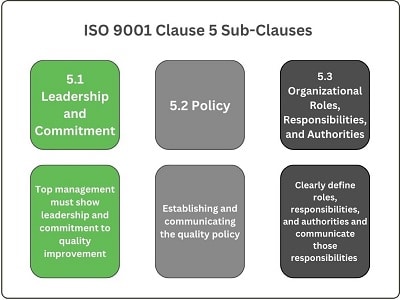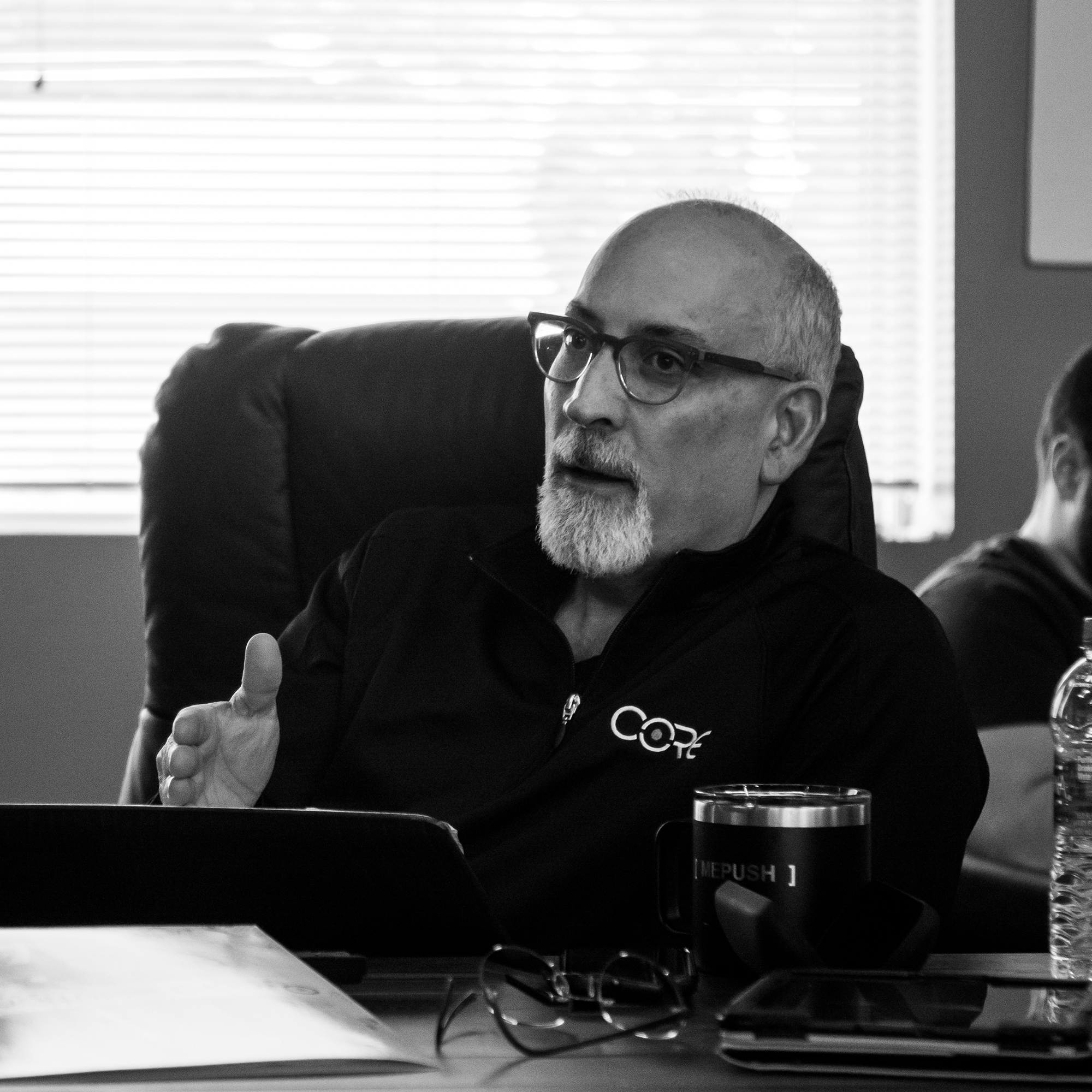ISO 9001:2015 Clause 5
What is the ISO 9001:2015 Clause 5?
Clause 5 of the ISO 9001:2015 standard, titled “Leadership,” serves the purpose of establishing the importance of leadership and top management’s commitment to driving the successful implementation of a quality management system (QMS). The overall purpose of this clause is to ensure that leadership within the organization plays a central role in promoting a culture of quality, setting strategic direction, and fostering continuous improvement.
Clause 5 emphasizes the importance of top management’s active involvement in shaping the organization’s quality culture and driving the QMS forward. It sets the tone for the organization’s commitment to quality and lays the groundwork for the subsequent clauses of ISO 9001.
The Specific Objectives of Clause 5, Leadership, are as follows:
1. Demonstrating Leadership and Commitment:
This clause requires top management to demonstrate their active involvement, commitment, and accountability for the effectiveness of the QMS. Leadership must establish and communicate a clear quality policy, set quality objectives, and ensure that the QMS is integrated into the organization’s business processes.
Get a Free Quote
2. Establishing a Quality Policy:
Top management is responsible for developing a quality policy that reflects the organization’s commitment to meeting customer requirements, complying with applicable regulations, and continuously improving its performance. The quality policy provides a framework for establishing quality objectives and serves as a guiding principle for all employees.
3. Defining Quality Objectives:
Top management must establish measurable quality objectives that align with the organization’s strategic goals and the needs and expectations of interested parties. Quality objectives should be communicated to employees and reviewed periodically to ensure their continued relevance and effectiveness.
4. Integrating the QMS into Business Processes:
Leadership plays a crucial role in ensuring that the QMS is integrated into the organization’s overall business processes. This involves promoting a culture of quality, ensuring appropriate resources are allocated, and fostering employee engagement and participation in the QMS implementation.
5. Supporting Risk-Based Thinking:
Leadership is responsible for promoting a proactive approach to risk management and opportunity identification. By fostering a culture of risk-based thinking, top management can ensure that potential risks are addressed, and opportunities for improvement are capitalized upon.
6. Ensuring Customer Focus:
Top management must prioritize customer focus by understanding customer needs and expectations, monitoring customer satisfaction, and taking actions to enhance customer experience. Leadership plays a key role in driving customer-centricity throughout the organization.
By addressing the objectives of Clause 5, organizations create a strong foundation for the successful implementation of their QMS. Effective leadership ensures that quality is a strategic priority, and it provides the necessary support, resources, and direction to drive continuous improvement and achieve customer satisfaction.

What are the Sub Clauses of Clause 5?
Clause 5 of ISO 9001:2015 covers the leadership aspects of a quality management system. It’s divided into several sub-clauses, each addressing different elements related to leadership’s role in establishing and supporting the quality management system. Here are the separate clauses within Clause 5:
5.1 Leadership and Commitment:
Clause 5.1 emphasizes the need for top management to demonstrate leadership and commitment to the QMS by taking accountability for its effectiveness, establishing quality policies, and ensuring integration of the QMS into the organization’s processes.
5.2 Policy:
Clause 5.2 focuses on the establishment of a quality policy that aligns with the organization’s purpose, supports its strategic direction, and provides a framework for setting quality objectives.
5.3 Organizational Roles, Responsibilities, and Authorities:
Clause 5.3 outlines the necessity to define and communicate roles, responsibilities, and authorities within the organization to ensure effective QMS implementation and continual improvement.
Each of these clauses within Clause 5 plays a crucial role in guiding leadership in establishing, implementing, and maintaining an effective quality management system aligned with the organization’s objectives and context.


How to Comply with Clause 5 of the ISO 9001:2015 Standard:
Complying with Clause 5, titled “Leadership,” in the ISO 9001 Standard involves demonstrating leadership commitment and involvement in the quality management system (QMS). Here are some examples of how an organization can comply with Clause 5:
1. Establish a quality policy:
Develop a quality policy that reflects the organization’s commitment to quality, customer satisfaction, and continuous improvement. The policy should be communicated and understood at all levels of the organization.
2. Define roles and responsibilities:
Clearly define the roles, responsibilities, and authorities within the organization for the effective implementation and maintenance of the QMS. Ensure that leadership positions have defined quality-related responsibilities.
3. Set quality objectives:
Establish measurable quality objectives that align with the organization’s strategic goals and reflect the commitment to customer satisfaction and continual improvement. These objectives should be communicated to relevant personnel and regularly reviewed for progress.
4. Provide resources:
Allocate appropriate resources, including personnel, infrastructure, technology, and financial resources, to support the effective implementation and maintenance of the QMS. Ensure that resources are available to meet the organization’s quality objectives.
5. Lead by example:
Demonstrate leadership commitment to quality by actively participating in QMS activities, such as management reviews, audits, and process improvement initiatives. Engage in open communication, promote a positive quality culture, and encourage employee involvement.
6. Communicate the importance of the QMS:
Communicate the importance of the QMS to all employees, ensuring that they understand how their roles contribute to quality and customer satisfaction. Regularly share updates on quality performance and encourage suggestions for improvement.
7. Establish a process for risk management:
Implement a process for identifying, assessing, and managing risks within the organization. Encourage proactive risk management practices and ensure that appropriate actions are taken to mitigate or address identified risks.
8. Support employee training and development:
Provide training and development opportunities to enhance employees’ skills and competencies related to quality management. This includes promoting awareness of the QMS requirements and providing necessary training on quality-related processes and procedures.
9. Encourage employee involvement:
Foster a culture of employee involvement and participation in quality improvement initiatives. Encourage employees to provide suggestions for process improvements, identify nonconformities, and contribute to corrective and preventive actions.
10. Monitor and review QMS performance:
Regularly monitor and review the performance of the QMS to assess its effectiveness and identify areas for improvement. Use management review meetings and performance indicators to evaluate the QMS and make data-driven decisions for continual improvement.
Compliance with Clause 5 demonstrates the organization’s commitment to quality leadership and active engagement in the QMS. By establishing a culture of quality, providing resources and support, and fostering employee involvement, organizations can drive continuous improvement, enhance customer satisfaction, and achieve their quality objectives.
The History of Clause 5 of the ISO9001 Standard
Clause 5 of the ISO 9001 standard, titled “Leadership,” has undergone significant changes throughout the history of the standard. Let’s explore the evolution of Clause 5 in different versions of ISO 9001:
ISO 9001:1987:
The initial version of ISO 9001, published in 1987, did not have a dedicated clause for “Leadership.” The standard primarily focused on quality assurance and control processes, without explicitly addressing the role of leadership in driving the quality management system (QMS).
ISO 9001:1994:
In the 1994 revision, ISO 9001 introduced the concept of a “Quality Manual” and “Quality Policy” in Clause 4, but it did not have a specific clause dedicated to leadership.
ISO 9001:2000:
The year 2000 brought significant changes to ISO 9001, including the introduction of the High-Level Structure (HLS) developed by ISO. Clause 5, titled “Management Responsibility,” was introduced to emphasize the importance of leadership in the QMS. It outlined requirements for top management to demonstrate their commitment, establish a quality policy, and ensure the QMS’s effectiveness.
ISO 9001:2008:
The 2008 revision did not bring major changes to Clause 5. The requirements remained consistent with the previous version, focusing on top management’s commitment, establishing the quality policy, and defining the quality objectives.
ISO 9001:2015:
The 2015 revision of ISO 9001 brought significant changes to Clause 5. It was restructured and expanded to emphasize leadership’s role in shaping the QMS and driving its success. The revised clause, titled “Leadership and Commitment,” includes explicit requirements for top management’s involvement, responsibility, and engagement in the QMS.
ISO 9001:2015 introduced specific sub-clauses under Clause 5, including:
5.1 Leadership and Commitment
5.2 Policy
5.3 Organizational Roles, Responsibilities, and Authorities
The current version of ISO 9001, ISO 9001:2015, places a strong emphasis on leadership’s active involvement and commitment to the QMS. It highlights the importance of establishing a quality policy, defining quality objectives, ensuring process performance, promoting a culture of quality, and providing resources for QMS implementation and improvement.
By strengthening the leadership requirements, ISO 9001:2015 aims to ensure that top management assumes an active role in setting the direction, establishing a quality culture, and driving continual improvement within the organization. This emphasis on leadership helps organizations achieve their quality objectives, enhance customer satisfaction, and deliver consistent and reliable products and services.
Consulting Support for ISO 9001
Every year, we help hundreds of small businesses achieve ISO 9001 certification. Support for ISO 9001 is available through any of our Consulting Programs
As an American business with a story like yours, we know that time is valuable. Our expert consultants are here to take on the difficult, technical aspects of certification so you can focus on your business. They’ll work with you every step of the way until you’re successfully certified.
Interested? Get a Free Quote.
In many industries, ISO 9001 has become a supply-chain requirement. When landing a big contract, ISO 9001 certification could make all the difference.
About Scott Dawson
Since 2010, Scott Dawson, President of Core Business Solutions, has been an active voting member of the U.S. Technical Advisory Group (TAG) to ISO Technical Committee 176 (TC 176). TAG 176 members meet to discuss and develop U.S. positions for Quality Management standards, including ISO 9001:2015, which will be revised in 2025.


About Core Business Solutions
"Core Business Solutions was started by my brother, Mike Dawson, and myself, true entrepreneurs at heart looking for a better way to make a living and help small businesses improve the quality of the products and services they provide.
The bottom line: we are real people that have developed a team to come along side you to help you grow and succeed."
-- Scott Dawson, President
Related Standards
We provide consulting support for various other standards, as well as support for companies seeking multiple certifications through an Integrated Management System.
AS9100
Aerospace Manufacturers
AS9120
Aerospace Distributors
ISO 14001
Environmental Management Systems
ISO 27001
Information Security Management Systems
ISO 20000-1
Service Management Systems
ISO 45001
OH&S Management Systems
ISO 13485
Medical Device Manufacturers
AS9100
AS9120
ISO 14001
ISO
20000-1
ISO 27001
ISO 45001
ISO 13485
Equip Your Business to Meet ISO 9001 With CORE
At Core Business Solutions, we’re here to equip your company for success in meeting ISO 9001 requirements. We’ve helped hundreds of small businesses grow and deliver the best solutions to their clients. We provide ISO 9001 employee and executive training services, consulting help, and compliance software and to help you get certified and stay certified. We focus on optimizing your processes and helping you implement an ISO-compliant QMS. When you partner with us, you’ll get the tools and help you need for success.
For more information on the ISO 9001:2015 standard, please visit our articles page. You can also call our consulting office at 866-354-0300 or contact us online.
Do you want to update your existing ISO 9001 QMS System or refresh it?
We provide consulting services to assist you in your ISO 9001 Quality Management System refresh. We listen, conduct a gap analysis, update your Quality Policy and any necessary documentation or procedures, find areas of waste or improvement, simplify and automate. And we do it fast. Core offers firm, fixed pricing. Download our information sheet today to learn more or call us at 866-354-0300 Extension 2.
